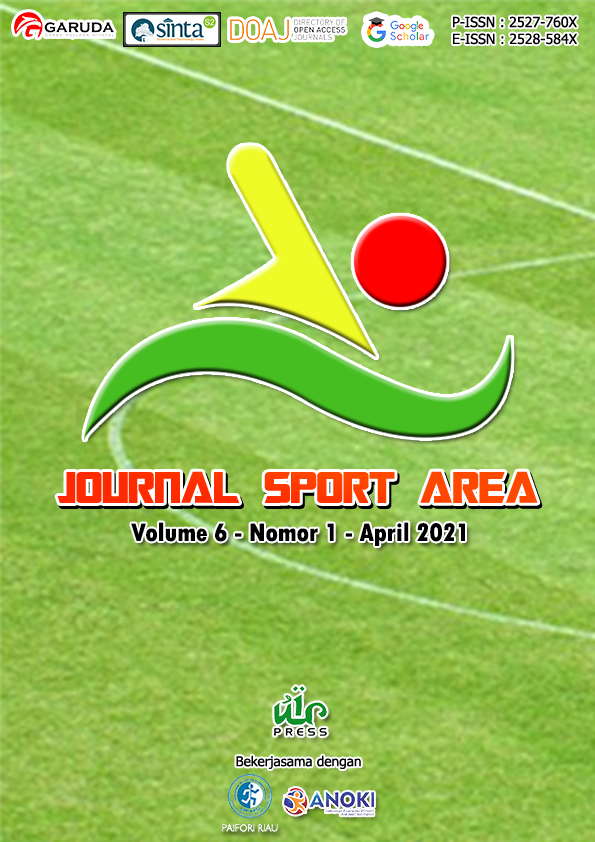Improving passing skills on volleyball using target games approach
Keywords:
Passing, physical education, target gamesAbstract
Passing on volleyball is important in volleyball games, but students have difficulty determining the exact passing result with the target. This study improves the passing skills on volleyball in volleyball learning on students of VII A grade in-state junior high school 1 Probolinggo using the target games approach. The research method uses Classroom Action Research. The implementation of this class action is by two cycles. Each cycle consists of 4 stages, namely (1) planning, (2) implementation, (3) observation, and 4) reflection. The subjects of this study are students of VII A grade in State Junior High School 1 Probolinggo. The collecting techniques of the data use observation sheets, documentation, and tests. The results of the passing skills test on volleyball in the first cycle, the number of students amount 30 people, there are 29 students able to do the passing beginning movement on the volleyball correctly 90.25% with good category, 27 students can do the movements correctly in the subject position of 81.12 % with good category, and 28 students are able to make the final movement correctly 80.25% with a good category. Based on the results of the study, it can be concluded that learning of passing on volleyball through the target games approach can improve the passing skills on volleyball of students in State Junior High School Probolinggo. It is hoped that in the future, research can be found that develops target games with other types of games to overcome student learning difficulties.
Downloads
References
Aggerholm, K., Standal, O., Barker, D. M., & Larsson, H. (2018). On practising in physical education: outline for a pedagogical model. Physical Education and Sport Pedagogy, 23(2), 197–208. https://doi.org/10.1080/17408989.2017.1372408
Araújo, R., Mesquita, I., Hastie, P., & Pereira, C. (2015). Students’ game performance improvements during a hybrid sport education–step-game-approach volleyball unit. European Physical Education Review, 22(2), 185–200. https://doi.org/10.1177/1356336X15597927
Broek, G. Vande, Boen, F., Claessens, M., Feys, J., & Ceux, T. (2011). Comparison of three instructional approaches to enhance tactical knowledge in volleyball among university students. Journal of Teaching in Physical Education, 30(4), 375–392. https://doi.org/10.1123/jtpe.30.4.375
Butler, J. I. L. L. G. (2010). More Teaching Games for Understanding Moving Globally. Australia: Human Kinetics.
Coulter, M., & Ní Chróinín, D. (2013). What is PE? Sport, Education and Society, 18(6), 825–841. https://doi.org/10.1080/13573322.2011.613924
Dudley, D. A., Okely, A. D., Cotton, W. G., Pearson, P., & Caputi, P. (2012). Physical activity levels and movement skill instruction in secondary school physical education. Journal of Science and Medicine in Sport, 15(3), 231–237. https://doi.org/10.1016/j.jsams.2011.10.005
Dyson, B. (2014). Quality physical education: A commentary on effective physical education teaching. Research Quarterly for Exercise and Sport, 85(2), 144–152. https://doi.org/10.1080/02701367.2014.904155
Escalante, Y., García-Hermoso, A., Backx, K., & Saavedra, J. M. (2014). Playground Designs to Increase Physical Activity Levels During School Recess: A Systematic Review. Health Education and Behavior, 41(2), 138–144. https://doi.org/10.1177/1090198113490725
Herbert, P. C., & Whitney, E. A. (2018). Physical Activity Stations: Opportunities for Teachers and Students during the School Day. Strategies, 31(5), 37–41. https://doi.org/10.1080/08924562.2018.1491712
Jaakkola, T., & Washington, T. (2013). The relationship between fundamental movement skills and self-reported physical activity during Finnish junior high school. Physical Education and Sport Pedagogy, 18(5), 492–505. https://doi.org/10.1080/17408989.2012.690386
Koshy, V. (2005). Action Research for Improving Practice. London: Paul Chapman Publisihing.
Lindberg, R., Seo, J., & Laine, T. H. (2016). Enhancing Physical Education with Exergames and Wearable Technology. IEEE Transactions on Learning Technologies, 9(4), 328–341. https://doi.org/10.1109/TLT.2016.2556671
Lodewyk, K. R., & Bracco, E. (2013). Differences in Adaptive Outcomes between Previous Physical Education and a Teaching Games for Understanding Games Unit in Adolescent Girls. Journal of Research PE.
Lucas, F. M. M. (2017). The Game as an Early Childhood Learning Resource for Intercultural Education. Procedia - Social and Behavioral Sciences, 237(June 2016), 908–913. https://doi.org/10.1016/j.sbspro.2017.02.127
M. Nur Mannan, Achmad Sopyan, S. (2015). Pengembangan Perangkat Pembelajaran Berbasis Kearifan Lokal untuk Menembangkan Karakter Positif Siswa SD. Jurnal Inovasi Dan Pembelajaran Fisika, 2(2), 141–146.
Memmert, D., Hillmann, W., Huttermann, S., Klein-Soetebier, T., Konig, S., Nopp, S., … Griffin, L. (2015). Top 10 research questions related to teaching games for understanding. Research Quarterly for Exercise and Sport, 86(4), 347–359. https://doi.org/10.1080/02701367.2015.1087294
Morgan, K. (2019). Applying the TARGET Pedagogical Principles in Physical Education to Enhance Students’ Physical Literacy. Journal of Physical Education, Recreation and Dance, 90(1), 9–14. https://doi.org/10.1080/07303084.2018.1535339
Nur, H. W. (2016). Pengaruh Permainan Target Terhadap Kemampuan Shooting Dalam Permainan Sepakbola Pada Siswa Kelas Khusus Olahraga Di SMA N 2 Playen Gunungkidul. Universitas Negeri Yogyakarta.
Perlman, D., Forrest, G., Pearson, P., & Pearson, P. (2012). Nintendo Wii : Opportunities to put the Education back into Physical Education. 37(7).
Pill, S. (2016). An Appreciative Inquiry Exploring Game Sense Teaching In Physical Education. Sport, Education and So, 3322(March). https://doi.org/10.1080/13573322.2014.912624
Slingerland, M., Haerens, L., Cardon, G., & Borghouts, L. (2014). Differences in perceived competence and physical activity levels during single-gender modified basketball game play in middle school physical education. European Physical Education Review, 20(1), 20–35. https://doi.org/10.1177/1356336X13496000
Sukardi, M. (2012). Metode Penelitian Tindakan. Yogjakarta: Bumi Aksara.
Krističević, T., Madić, D., & Krakan, I. (2016). Effect of Game-based Conditioning Training on Volleyball Skill Accuracy in Junior Players. Acta Kinesiologica. 10(1), 15-19. https://doi.org/10.1017/CBO9781107415324.004
Winarno, M. E. (2006). Tes Keterampilan Olahraga. Malang: Laboratorium Jurusan Ilmu Keolahragaan FIP UM.
Published
How to Cite
Issue
Section
This is an open-access article distributed under the terms of the Creative Commons Attribution-ShareAlike 4.0 International License which permits unrestricted use, distribution, and reproduction in any medium. Copyrights of all materials published in Journal Sport Area are freely available without charge to users or / institution. Users are allowed to read, download, copy, distribute, search, or link to full-text articles in this journal without asking by giving appropriate credit, provide a link to the license, and indicate if changes were made. All of the remix, transform, or build upon the material must distribute the contributions under the same license as the original.
Accepted 2020-12-06
Published 2021-01-05












